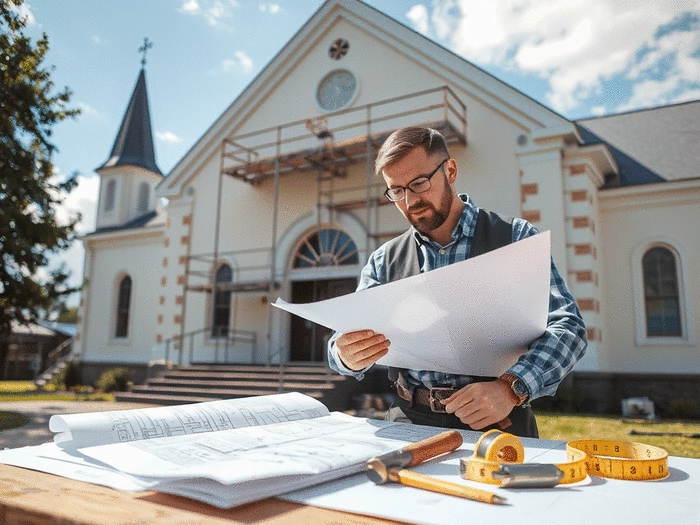Aging Infrastructure
Regular assessments are crucial to identify wear and tear early, preventing minor issues from becoming major problems.
Get exclusive insights, tips, and updates on home renovations and facility maintenance from Myles Properties.
Posted on: 2025-11-06
By: Samuel T. Masters
Regular maintenance of church buildings is essential not only for safety but also for preserving community values. Consider this: a proactive approach can save both time and money, ensuring that these vital spaces continue to serve their purpose for generations to come.
Maintaining church facilities involves understanding common challenges and implementing effective solutions.
Regular assessments are crucial to identify wear and tear early, preventing minor issues from becoming major problems.
Consistent inspection and maintenance of roofs can prevent leaks and structural damage, saving significant repair costs.
Timely restoration helps preserve both the aesthetic appeal and structural integrity of church walls and ceilings.
Implementing modern solutions like dehumidifiers protects the interior from long-term moisture damage and mold.
As someone who has spent over 25 years in the rehab and maintenance industry, I can assure you that regular maintenance is crucial for church buildings. These facilities are not just places of worship; they serve as community hubs, often hosting events, gatherings, and activities that bring people together. Without proper upkeep, these spaces may face deterioration that could compromise their safety and functionality.
Maintaining church facilities goes beyond aesthetics—it's about preserving the integrity of the structure and ensuring it serves the community well for years to come. When we consider the significant investment that congregations make in their buildings, it becomes clear that proactive maintenance can save both time and money in the long run!
Regular maintenance helps to identify and address issues before they escalate into costly repairs. Here are some key reasons why it's critical:
In my experience at Myles Properties, we have seen firsthand how consistent maintenance leads to thriving church facilities. By addressing maintenance needs regularly, church leaders can focus on their mission rather than worrying about potential repairs.
While the importance of maintenance is clear, church stewards often encounter several challenges that can make it difficult to keep up with repairs. These include:
At Myles Properties, we strive to support church stewards by offering our expertise and affordable solutions to these challenges. With a clear understanding of the specific needs of church facilities, we can help ensure they remain safe, inviting, and functional for everyone in the community.
As church buildings age, they inevitably face a variety of maintenance issues that need to be addressed. By identifying these problems early, we can take proactive measures to rectify them. Let’s explore some common issues and how to manage them effectively.
To enhance your church's maintenance efforts, consider creating a dedicated maintenance team from your congregation. This team can be responsible for regular inspections and minor repairs, fostering a sense of community ownership and ensuring that everyone is invested in the upkeep of your beloved space.
As we wrap up this discussion on church building repair, it's crucial to revisit the common challenges and the effective solutions we've explored. Many church facilities face a variety of issues, from aging infrastructure to moisture problems. Understanding these common challenges allows us to respond proactively. The Church in Wales's annual report on the care of church buildings offers further insights into these challenges and potential solutions.
In summary, here are some of the key issues and their solutions we've covered:
By addressing these issues head-on, churches can ensure that their facilities remain welcoming and functional for the community.
Creating a long-term maintenance plan is vital for any church. This plan not only helps in managing finances but also ensures the church remains a safe haven for worship and community gatherings. Establishing a schedule for regular maintenance tasks can significantly reduce costly repairs down the line. Here are some benefits of having a long-term maintenance strategy:
Overall, a well-planned maintenance strategy not only protects the church's physical structure but also strengthens the community's bond.
Regular maintenance is crucial for several reasons: it ensures the safety of congregants, leads to financial savings by preventing costly repairs, preserves the historical legacy of the building, and builds community trust by maintaining an inviting space.
Churches often struggle with budget constraints, limitations due to reliance on volunteers, the increased repair needs of older buildings, and a lack of specialized expertise among church members for complex maintenance issues.
Proactive assessments are key to identifying wear and tear early. Regular inspections and timely repairs can prevent minor issues from escalating into major problems, saving significant time and money.
A long-term maintenance plan offers several benefits, including improved cost efficiency through better fund allocation, enhanced safety due to regular inspections, and increased community engagement as members become more involved in upkeep.
Churches can foster community spirit through volunteer days, surveys to gather feedback on needed repairs, and workshops on basic maintenance skills. Engaging the congregation helps create a sense of ownership and collaboration.
Engaging your congregation in church maintenance is a powerful way to foster community spirit. By inviting feedback and participation, you not only gather valuable insights but also help your members feel invested in the church's upkeep. Simple initiatives, like community meetings or suggestion boxes, can make a big difference!
Consider these effective methods for encouraging participation:
These actions can create a collaborative environment that enhances the church's functionality and community relationships.
As you move forward with your church maintenance projects, having the right resources at your disposal is key. Here are some practical next steps to ensure successful repairs:
By taking these steps, you're well on your way to creating a space that serves your community beautifully and securely!
To maximize your church maintenance efforts, implementing a community outreach strategy is essential. Reach out to local businesses, organizations, and individual volunteers who may be interested in supporting your church. Here are a few strategies to consider:
These proactive outreach efforts not only enhance your church's maintenance capabilities but also build a stronger community.
Here is a quick recap of the important points discussed in the article:



 Have you ever considered how upgrading your home can not only save you money but also contribute to
Have you ever considered how upgrading your home can not only save you money but also contribute to
 Imagine you’re responsible for the upkeep of a bustling facility, and one day you discover a signi
Imagine you’re responsible for the upkeep of a bustling facility, and one day you discover a signi
 Deciding between outsourcing and in-house facility maintenance can feel like navigating a maze. The
Deciding between outsourcing and in-house facility maintenance can feel like navigating a maze. The